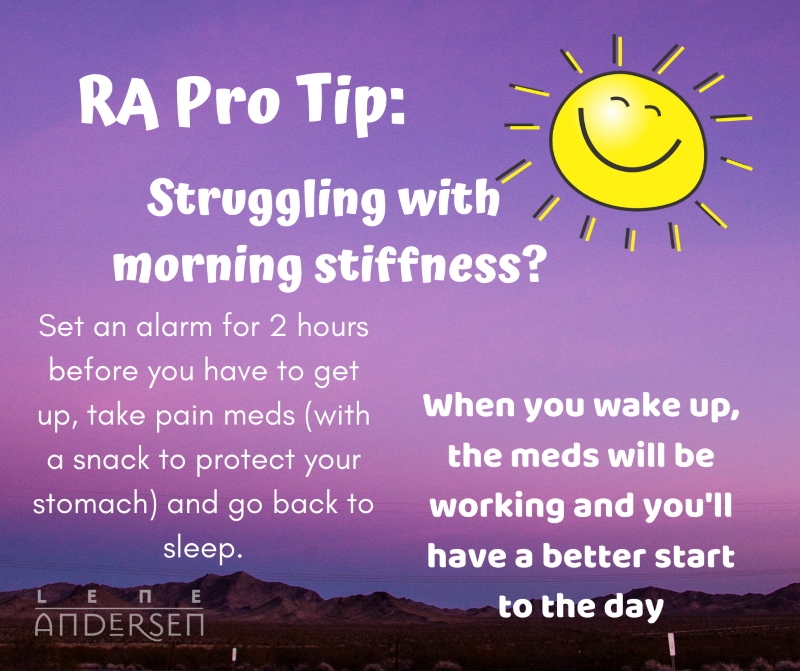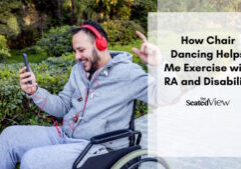RA Pro Tips: How to Get Ahead of Morning Stiffness and Pain

Of the many things that are hard about living with rheumatoid arthritis (RA), one of the most dispiriting is perhaps the inability to start the day with any sort of brightness and flair. Upon waking, there’s that split second of looking forward to the new day before you’re hit with the anticipatory freeze while you do the physical check, asking your body “how bad is it today?” The answer is usually pretty bad — up to 80% of people who live with RA have morning stiffness and pain, even during remission, which can affect their ability to do morning tasks. But it doesn’t have to be that way. Many years ago, I was introduced to a wonderful and super simple trick that guarantees you can start the day ahead of the pain.

But first: Why does RA cause morning stiffness and pain?
Morning stiffness is one of the defining characteristics of RA and can be used to differentiate what’s happening in your body. For instance, if your morning stiffness last more than an hour, chances are you have RA rather than osteoarthritis. Although the exact mechanisms behind morning stiffness are still a bit of a mystery, we are beginning to understand the cause behind why so many people feel like creaky robots when first waking up.
It has to do with circadian rhythms. This is a cycle of about 24 hours in which the physiological processes of all living beings — including humans, animals, and plants — change depending on the time of day. It causes changes in hormones, brain waves, and regeneration of cells. And one more thing: inflammatory cytokines increase in production in the early morning. So basically, when you have RA, you likely have more inflammation in the morning. As well, when you’ve been still for a while, either by sleeping or watching TV, your synovial fluid has a harder time doing its job — which is essentially lubricating the joints, just like a bit of WD-40.
This gets even more complicated when synovial fluid has a high level of inflammation, but that’s beyond the scope of this post. If you want to learn more about the deeper biological aspects, check my sources below for more information.
Let’s get to the important bit: how to deal with it.

What you can do to reduce morning stiffness and pain
When I was a childhood juvenile arthritis, I spent a lot of time in a rehab hospital. So much of this was awful, but I did learn one essential tip for starting the day without debilitating stiffness and pain and I’ve been using it ever since.
Step 1. Set your alarm clock for a couple of hours before you have to get up. For instance, if you normally get up at 7 AM, set it to about 5 AM.
Step 2. Take your pain meds along with a bite of apple or a cracker.
Step 3. Go back to sleep for a few hours.
By the time you have to get up, the medication is working and you are ahead of the pain. This is key to pain management — see it as being in a race with the pain and when you full behind, it’s really hard to catch up again. But starting the day ahead can have a profound impact on your ability to get going.
I bet you have a few questions. Here are the answers:
Why two hours between taking the medication and waking up again? The two hours is important, as it can allow you to sleep through one or two sleep cycles, getting the full impact of the healing qualities of deep sleep.
Why should I eat something with the meds? Medication can be hard on an empty stomach. Leave an apple, a few crackers, or small box of raisins next to your bed before you go to sleep so you can eat something with your meds. This will help protect your stomach.
What if I can’t fall asleep again? Back in those days at the hospital, I at first had trouble going back to sleep after the nurse had passed around medication. It can feel frustrating initially, but chances are you’ll quickly train your body to fall back asleep again. The pain medication can make this easier by relaxing your body.

How to get even further ahead of your morning pain
Once you wake up for the day, don’t leave your bed immediately. Spend five minutes doing range of motion exercises, moving your joints through bending and stretching. This gets that biological WD-40 moving, but gently, so that when you get out of bed, you already warmed up. Think of it this way: athletes don’t run without warming up first. When you have RA, your days are even more of a marathon, so warming up is important. To help that process have even more power for your body, have a warm shower before you get dressed. Hot water can thaw out your body, reducing your pain even more.
This morning routine trio of pain medication, range of motion exercises, and a warm shower can be a powerful tool in reducing your pain and stiffness from the get go. And that will always make for a better day.
Let me know how this works for you!
Check My Sources
“Circadian Rhythm.” Accessed October 10, 2020. https://www.sciencedaily.com/terms/circadian_rhythm.htm.
Gibbs, Julie E, and David W Ray. “The Role of the Circadian Clock in Rheumatoid Arthritis.” Arthritis Research & Therapy 15, no. 1 (2013): 205. https://doi.org/10.1186/ar4146.
Kobayashi, Yoshihisa, Kei Ikeda, Takayuki Nakamura, Mieko Yamagata, Takuya Nakazawa, Shigeru Tanaka, Shunsuke Furuta, Takeshi Umibe, and Hiroshi Nakajima. “Severity and Diurnal Improvement of Morning Stiffness Independently Associate with Tenosynovitis in Patients with Rheumatoid Arthritis.” Plos One 11, no. 11 (2016). https://doi.org/10.1371/journal.pone.0166616.
Phillips, Sarah, and Lara Dow. “Impact of Impaired Morning Function on Quality of Life in Rheumatoid Arthritis: Results of an Exploratory Patient Survey.” International Journal of Clinical Rheumatology 7, no. 6 (2012): 597–606. https://doi.org/10.2217/ijr.12.62.
“RA Pathophysiology • Johns Hopkins Arthritis Center.” Johns Hopkins Arthritis Center, March 27, 2019. https://www.hopkinsarthritis.org/arthritis-info/rheumatoid-arthritis/ra-pathophysiology-2/.
Sierakowski, S, and M Cutolo. “Morning Symptoms in Rheumatoid Arthritis: a Defining Characteristic and Marker of Active Disease.” Scandinavian Journal of Rheumatology 40, no. sup125 (2011): 1–5. https://doi.org/10.3109/03009742.2011.566433.
Tuyl, Lilian Hd Van, Willem F Lems, and Maarten Boers. “Measurement of Stiffness in Patients with Rheumatoid Arthritis in Low Disease Activity or Remission: a Systematic Review.” BMC Musculoskeletal Disorders 15, no. 1 (2014). https://doi.org/10.1186/1471-2474-15-28.
Yoshida, Kohsuke, Teppei Hashimoto, Yoshitada Sakai, and Akira Hashiramoto. “Circadian Rhythm and Joint Stiffness/Destruction in Rheumatoid Arthritis.” International Journal of Clinical Rheumatology 10, no. 5 (2015): 335–44. https://doi.org/10.2217/ijr.15.35.
13 Comments
Read More
Discover what else I've been writing about...
















I have a family friend that has RA and we got to talking this weekend and this has been one of the major complaints. Morning stiffness and learning to deal with it. I’ll make sure to pass this along as potential way to combat the issue.
This season of Lockdown has made me have morning stiffness and pain a lot more. It hurts so much. So Im glad to read this post today. Thanks for sharing.
This season of Lockdown has made me have morning stiffness and pain a lot more. It hurts so much. So Im glad to read this post today. Thanks for sharing this.
This post was so helpful. I don’t suffer with RA, but lately I have been experiencing morning stiffness in one shoulder. I’ve been told that I need to correct my sleeping position. I will pass this information a long to a few people that I do know that have morning stiffness due to RA. Thank you!
when I have morning stiffness, I ask Sheryl to hit me with a board across my forehead. That way I can gauge if I am really am as stiff as a board, and at the same time i can find out if really am hard headed.
Most days, yeah I am.
Great tips for reducing the morning stiffness that is associated with RA. It must be awful to wake up every day with pain and stiffness.
This is great – thank you. I will send to my friend with RA in her early thirties. The bit about the circadian rhythms is totally new to me – that’s really interesting. Thank you
This is great – thank you. I will send to my friend with RA in her early thirties. The bit about the circadian rhythms is totally new to me – that’s really interesting.
I had never even thought about waking up for medications and then going back to sleep to “miss” the first cycles of RA symptoms, or anything else, for that matter. But it is a great idea! I will pass this information on to a friend who deals with arthritis due to his profession. I know he wakes up early in the morning and then goes back to sleep for a couple more hours, so that is perfect. I will also try this when I wake up with a headache too, and see if it helps with even simple issues like that.
It was a great read as of late I am experiencing quite a bit of stiffness. Sometimes it’s in the morning and also other times during the day. I was wondering whether it is because I have got a little lazy when it comes to exercising. My sister has suffered from rheumatic arthritis since her childhood and would find this post useful too. I too also need to analyze my current problem.
Ah okay these are some good tips for those with RA. I’m sure they help!
These are great tips for those who suffer from RA. I’ve never heard of it before but will surely share with my friends or fam who m right need them.
I do hope I will never need those tips but I do have a friend who needs it. I’ll send this over to her